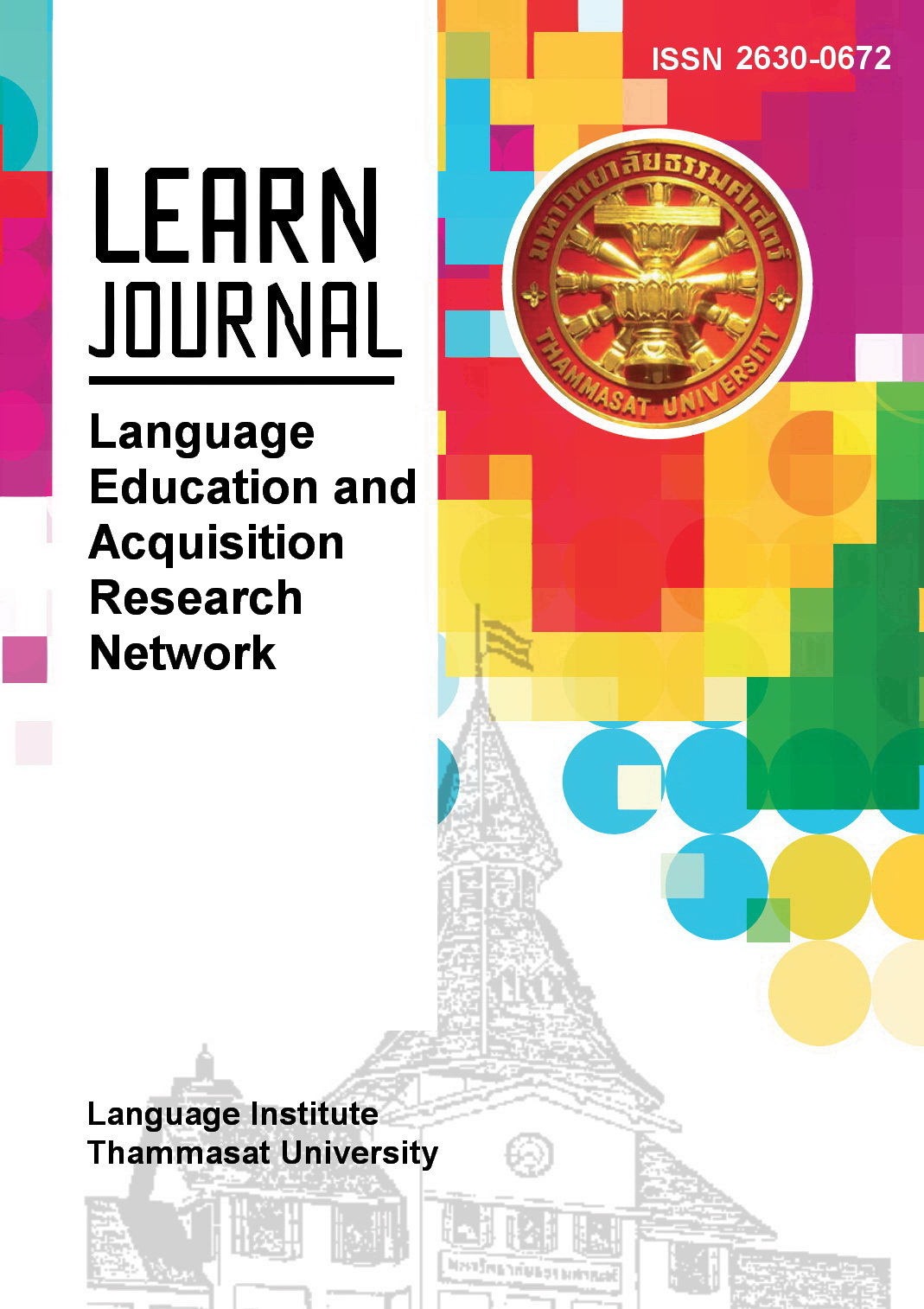A Multimodal Critical Discourse Analysis of Online Soft Drink Advertisements
Main Article Content
Abstract
The objectives of this study are to investigate verbal and visual semiotic resources employed as well as the cultural aspects embedded in the online soft drink advertisements. The data of this study was selected from the U.S. official soft drink brand Coca-Cola Instagram account (@cocacola), and a total of 58 advertisements were analyzed. Three analytical frameworks were employed to analyze the data. First, Nilsen (1979)’s phonetic devices framework was used for verbal resources analysis. Second, Kress & van Leeuwen (2006)’s and Harrison (2008)’s social semiotics frameworks were adapted for analyzing visual resources. Third, Hofstede et al. (2010)’s cultural dimensional model was employed to discuss the cultural aspects in the advertisements. The analysis of the verbal resources in the advertisements reveal two types of phonetic devices: alliteration and assonance. For the visual analysis, the advertisements tend to use the brand’s color, red, instead of a logo to make the brand memorable. The representative participants (RP)’ positions and gazes also give the sense of equality between the viewers and the brand. Most of the advertisements use visual resources that complement the verbal resources in order for the advertisements to be coherent as well as being able to convey the embedded cultural aspects. Two cultural aspects out of six were found: masculinity and indulgence. In addition, the study also found religious aspects embedded in the data.
Article Details
References
Aaker, D. (1991). Managing brand equity. The Free Press.
Aaker, D., & Joachimsthaler, E. (2000). Brand leadership. The Free Press.
Bi, M. (2019). Multimodal discourse analysis of Coca-Cola's advertising. International Journal of Social Research, 3(33). Retrieved May 13, 2021, from https://escipub.com/Articles/IJSR/IJSR-2019-09-0806.pdf
Campbell, J. L., Quincy, C., Osserman, J., Pedersen, O. K. (2013). Coding in-depth semistructured interviews: Problems of unitization and intercoder reliability and agreement. Sociological Methods & Research, 42, 294–320. http://doi.org/10.1177/0049124113500475
Coca-Cola. (2019, January 24). Coca-Cola uses super bowl to celebrate unity and diversity in both its advertising and hometown: Together is beautiful. Coca-Cola. https://www.coca-colacompany.com/news/coca-cola-uses-super-bowl-to-celebrate-unity
Cook, G. (2001). The discourse of advertising (2nd ed.). Routledge.
Crystal, D. (2001). Language play. The University of Chicago Press.
Crystal, D. (2008). A dictionary of linguistics and phonetics (6th ed). Blackwell Publishing.
Danesi, M. (2015). Advertising discourse. The international encyclopedia of language and social interaction, 1–10. http://doi.org/10.1002/9781118611463.wbielsi137
de Mooij, M.K. (2013). Global marketing and advertising: Understanding cultural paradoxes (4th ed.). Sage.
de Mooij, M.K., & Hofstede, G. (2010). The Hofstede model: Applications to global branding and advertising effectiveness. Journal of Marketing Research, 31(1), 57-64. http://doi.org/10.2501/S026504870920104X
Devis, D. F., Bagchi, R., & Block, L.G. (2016). Alliteration alters: Phonetic overlap in promotional messages influences evaluations and choice. Journal of Retailing, 92(1), 1-12. http://doi.org/10.1016/j.jretai.2015.06.002
Dubovičienė, T., & Skotupa, T. (2014). The analysis of some stylistic features of English advertising slogans. Foreign Languages, 16(3), 61-75. http://doi.org/10.15823/zz.2014.013
Encyclopedia Britannica. (2011). Star of Bethlehem. Encyclopaedia Britannica online. Retrieved August 2, 2021, from https://www.britannica.com/event/Star-of-Bethlehem-celestial-phenomenon
Fairclough, N. (1989). Language and power. Longman Inc.
Fairclough, N. (2015). Language and power (3rd ed.). Routledge.
Forbes. (2019). Global 2000 – Most valuable brands. Forbes. https://www.statista.com/page/forbes-global2000-most-valuable-brands-2019
Halliday, M. A. K. (1978). Language as social semiotic: The social interpretation of language and meaning. Edward Arnold.
Halliday, M. A. K., & Hasan, R. (1989). Language, context and text: Aspects of language in a social-semiotic perspective (2nd ed.). Oxford University Press.
Harris, Z. S. (1952). Discourse analysis. Language, 28(1), 1-30. http://doi.org/10.2307/409987
Harrison, C. (2008). Real men do wear mascara: Advertising discourse and masculine identity. Critical Discourse Studies, 5(1), 55-74. http://doi.org/10.1080/17405900701768638
Hofstede, G., Hofstede, G. J. & Minkov, M. (2010). Cultures and organizations: Software of the mind (3rd ed.). McGraw-Hill
Hu, C., & Luo, M. (2016). A social semiotic analysis of air France’s print advertisements. International Journal of English Linguistics, 6(4), 30-40. http://doi.org/ 10.5539/ijel.v6n4p30
Jewitt, C., & Oyama, R. (2001). Visual Meaning: A Social Semiotic Approach. In T. van Leeuwen & C. Jewitt (Eds.), Handbook of visual analysis (pp. 134–156). Sage.
Jewitt, C. (2009). The Routledge handbok of multimodal analysis. London, Routledge Falmer.
Kress, G., & van Leeuwen, T. (2006). Reading images: The grammar of visual design (2nd ed.). Routledge.
Kuswandini, E. (2018). Multimodal analysis of car advertisements. 228(Klua), 348–352. http://doi.org/10.2991/klua-18.2018.52
Moriarty, S., Mitchell, N., Wood, C., & Wells, W. (2018). Advertising & IMC. (7th ed.). Pearson.
Nathaniel, J., Evans, Phua, J., Jay, L., & Hyoyeun, J. (2017). Disclosing Instagram influencer advertising: The effects of disclosure language on advertising recognition, attitudes, and behavioral intent. Journal of Interactive Advertising, 2(17), 138-149. http://doi.org/10.1080/15252019.2017.1366885
Nilsen, D. L. F. (1979). Language play in advertising: Linguistic invention in product naming. In J. E. Atlas & G. R. Tucker (Eds.), Language in Public Life (pp. 137–143). Georgetown University Press.
O'Connor, C. & Joffe, H. (2020). Intercoder reliability in qualitative research: Debates and practical guidelines. International Journal of Qualitative Methods, 19, 1-13. http://doi.org/10.1177/1609406919899220
Paltridge, B. (2012). Discourse analysis. (2nd ed.). Bloomsbury.
Reece, B. B., Vanden Bergh, B. G., & Li, H. (1994). What makes a slogan memorable and who remembers it. Journal of Current Issues & Research in Advertising, 16(2), 41 - 57.
http://doi.org/10.1080/10641734.1994.10505018
Statista. (2020). Most popular social networks worldwide as of July 2020, ranked by number of active users. Statista. Retrieved September 17, 2020, from https://www.statista.com/statistics/272014/global-social-networks-ranked-by-number-of-users/
Swant, M. (2020). The world's most valuable brands. Forbes. https://www.forbes.com/the-worlds-most-valuable-brands/#305362df119c
van Dijk, T. A. (2009). Society and discourse: How social contexts influence text and talk. Cambridge University Press.
Zhou, W. (2018). Stylistic analysis of English advertising language. Proceedings of the International Conference on Contemporary Education, Social Sciences and Ecological Studies (CESSES 2018). https://doi.org/10.2991/cesses-18.2018.89


